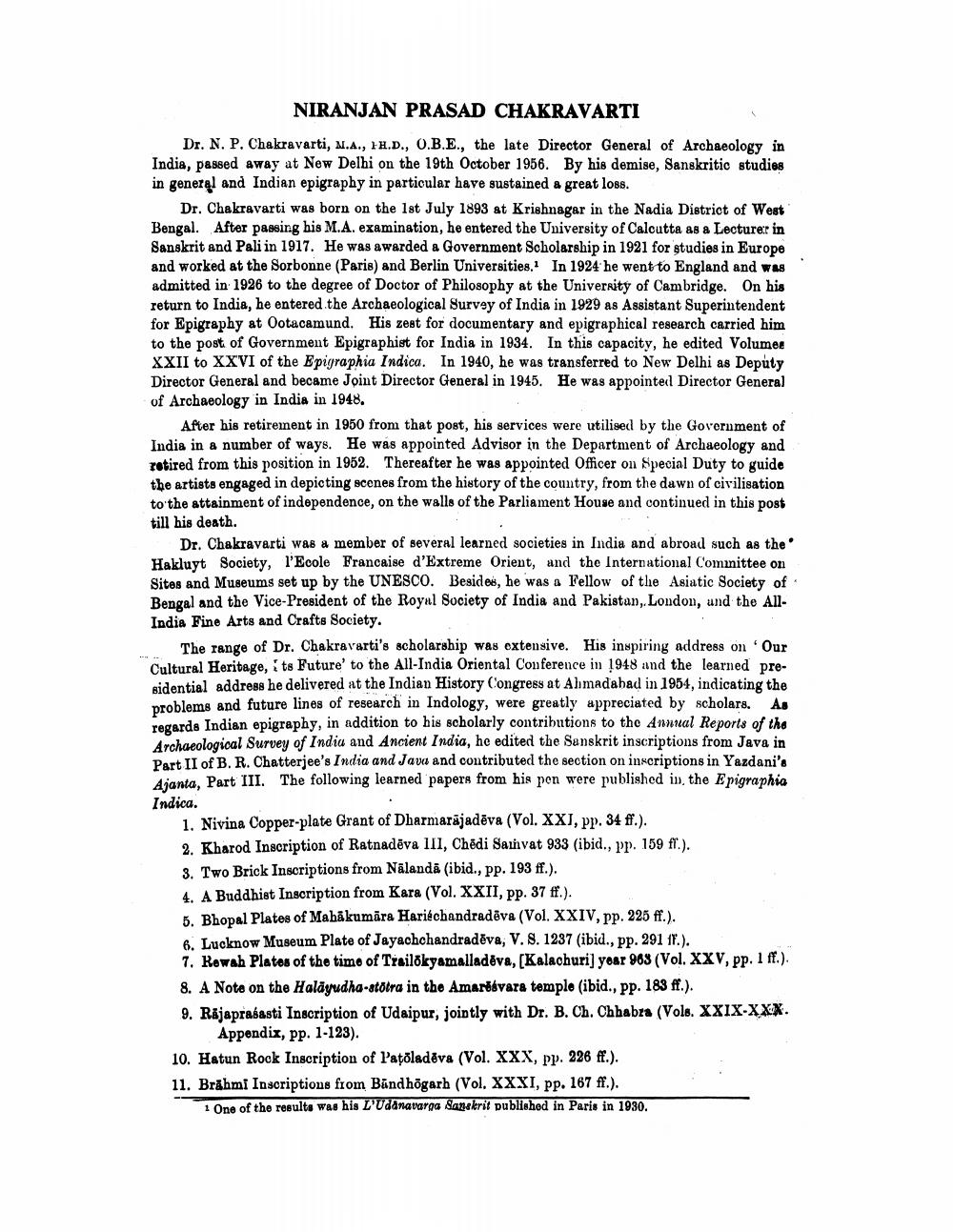________________
NIRANJAN PRASAD CHAKRAVARTI
Dr. N. P. Chakravarti, M.A., HH.D., O.B.E., the late Director General of Archaeology in India, passed away at New Delhi on the 19th October 1956. By his demise, Sanskritic studies in general and Indian epigraphy in particular have sustained a great loss.
Dr. Chakravarti was born on the 1st July 1893 at Krishnagar in the Nadia District of West Bengal. After passing his M.A. examination, he entered the University of Calcutta as a Lecturer in Sanskrit and Pali in 1917. He was awarded a Government Scholarship in 1921 for studies in Europe and worked at the Sorbonne (Paris) and Berlin Universities. In 1924 he went to England and was admitted in 1926 to the degree of Doctor of Philosophy at the University of Cambridge. On his return to India, he entered the Archaeological Survey of India in 1929 as Assistant Superintendent for Epigraphy at Ootacamund. His zest for documentary and epigraphical research carried him to the post of Government Epigraphist for India in 1934. In this capacity, he edited Volumes XXII to XXVI of the Epigraphia Indica. In 1940, he was transferred to New Delhi as Deputy Director General and became Joint Director General in 1945. He was appointed Director General of Archaeology in India in 1948.
After his retirement in 1950 from that post, his services were utilised by the Government of India in a number of ways. He was appointed Advisor in the Department of Archaeology and retired from this position in 1952. Thereafter he was appointed Officer on Special Duty to guide the artists engaged in depicting scenes from the history of the country, from the dawn of civilisation to the attainment of independence, on the walls of the Parliament House and continued in this post till his death.
Dr. Chakravarti was a member of several learned societies in India and abroad such as the Hakluyt Society, l'Ecole Francaise d'Extreme Orient, and the International Committee on Sites and Museums set up by the UNESCO. Besides, he was a Fellow of the Asiatic Society of Bengal and the Vice-President of the Royal Society of India and Pakistan, London, and the AllIndia Fine Arts and Crafts Society.
The range of Dr. Chakravarti's scholarship was extensive. His inspiring address on 'Our Cultural Heritage, its Future' to the All-India Oriental Conference in 1948 and the learned presidential address he delivered at the Indian History Congress at Ahmadabad in 1954, indicating the problems and future lines of research in Indology, were greatly appreciated by scholars. As regards Indian epigraphy, in addition to his scholarly contributions to the Annual Reports of the Archaeological Survey of India and Ancient India, he edited the Sanskrit inscriptions from Java in Part II of B. R. Chatterjee's India and Java and contributed the section on inscriptions in Yazdani's Ajanta, Part III. The following learned papers from his pen were published in, the Epigraphia
Indica.
1. Nivina Copper-plate Grant of Dharmarajadēva (Vol. XXI, pp. 34 ff.).
2. Kharod Inscription of Ratnadeva III, Chedi Samvat 933 (ibid., pp. 159 ff.).
3. Two Brick Inscriptions from Nālandā (ibid., pp. 193 ff.).
4. A Buddhist Inscription from Kara (Vol. XXII, pp. 37 ff.).
5. Bhopal Plates of Mahākumāra Hariéchandradeva (Vol. XXIV, pp. 225 ff.).
6. Lucknow Museum Plate of Jayachchandradeva, V. S. 1237 (ibid., pp. 291 ff.).
7. Rewah Plates of the time of Trailökyamalladeva, [Kalachuri] year 963 (Vol. XXV, pp. 1 ff.).
8. A Note on the Halayudha-stötra in the Amaréévara temple (ibid., pp. 183 ff.).
9. Rajaprasasti Inscription of Udaipur, jointly with Dr. B. Ch. Chhabra (Vol. XXIX-XXX. Appendix, pp. 1-123).
226 ff.).
10. Hatun Rock Inscription of Patōladēva (Vol. XXX, pp. 11. Brahmi Inscriptions from Bandhōgarh (Vol. XXXI, pp. 167 ff.).
1 One of the results was his L'Udânavarga Sanskrit published in Paris in 1930.




